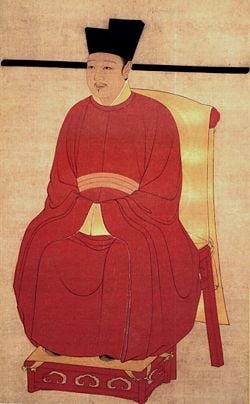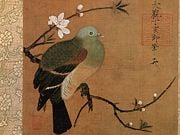Emperor Huizong of Song
| Emperor Huizong of Song | |
|---|---|
| Birth and death: | 2 November, 1082–4 June, 1135 |
| Family name: | Zhao (趙) |
| Given name: | Ji (佶) |
| Dates of reign: | 24 February, 1100–18 January, 1126¹ |
| Dynasty: | Song (宋) |
| Temple name: | Huizong (徽宗) |
| Posthumous name: (short) |
Never used short |
| Posthumous name: (full) |
Emperor Tishen Hedao Junlie Xungong Shengwen Rende Xianci Xianxiao Huangdi² 體神合道駿烈遜功聖文仁德 憲慈顯孝皇帝 |
| General note: Dates given here are in the Julian calendar. They are not in the proleptic Gregorian calendar. ——— 1. Abdicated in favor of his son, and was granted the title Taishang Huang (太上皇). Was demoted to the rank of commoner by the Jin on March 20, 1127. 2. Given in 1143. | |
Emperor Huizong (November 2, 1082 – June 4, 1135) was the eighth and one of the most famous emperors of the Song Dynasty of China, with a personal life spent amidst luxury, sophistication and art but ending in tragedy.
Born Zhao Ji, he was the 11th son of Emperor Shenzong. In February 1100 his older half-brother Emperor Zhezong (哲宗) died childless, and Huizong succeeded him the next day as emperor. He reigned from 1100 to 1126.
Huizong was famed for his promotion of Taoism, and was one of the three Chinese emperors to prohibit Buddhism. He was also a skilled poet, painter, calligrapher, and musician. He sponsored numerous artists at his court, and the catalogue of his imperial painting collection lists over 6,000 known paintings.[1]
His temple name means "Honorary Ancestor."
Biography
Emperor Huizong of Song, besides his partaking in state affairs that favored the Reformist party (refer to section on reformers and conservatives in Song Dynasty), was a cultured leader who spent much of his time admiring the arts. He was a collector of paintings, calligraphies, and antiques of previous Chinese eras, building huge collections of each for his amusement. He wrote poems of his own, was known as an avid painter, created his own calligraphy style, had interests in architecture and garden design, and even wrote treatises on medicine and Daoism.[2] He assembled an entourage of court painters that were first pre-screened in an examination to enter as official artists of the court, and made reforms to court music that was played.[2] Like many learned men of his age, he was quite a polymath personality. However, his reign would be forever scarred by the decisions made (by council given to him) on handling foreign policy, as the end of his reign marked a period of disaster for Song China.
A true artist, Huizong neglected the army, and Song China became increasingly weak and at the mercy of foreign enemies. When the Jurchen of Manchuria founded the Jin Dynasty and attacked the Liao kingdom to the north of the Song empire, the Song court allied with the Jin and attacked the Liao from the south. This succeeded in destroying the Liao kingdom, a long time enemy of the Song. However, an enemy even more formidable, the Jin, was now on the northern border. Not content with the annexation of the Liao kingdom, and measuring rightly the weakness of the Song empire, the Jin soon declared war on their former ally, and by the beginning of 1126 they crossed the Yellow River and came in sight of Kaifeng, the capital of the Song empire. Stricken with panic, Huizong abdicated on January 18, 1126 in favor of his son who became Emperor Qinzong (欽宗).
Overcoming the walls of Kaifeng was a difficult undertaking for the Jin cavalry, and this, conjugated with fierce resistance from some Chinese officials who had not totally lost their temper like Huizong, resulted in the Jin raising the siege of Kaifeng and returning north. The Song empire, however, had to sign a humiliating treaty with the Jin, agreeing to pay a colossal war indemnity and to give a tribute to Jin every year.
But even such humiliating terms could not save the hopeless Song empire. Within a matter of months, the Jin were back south again, and this time they were determined to overcome the walls of Kaifeng. After a bitter siege, the Jin eventually entered Kaifeng on January 9, 1127, and many days of looting, rapes, and massacre followed. Huizong, his son Emperor Qinzong, as well as the entire imperial court and harem were captured by the Jin in the Jingkang Incident. One of the sons of Huizong managed to escape to Southern China where, after many years of struggle, he would establish the Southern Song Dynasty, of which he was the first emperor, Emperor Gaozong (高宗).
Huizong and Qinzong were demoted to the rank of commoners by the Jin on March 20, 1127. Then on May 10, 1127, Huizong was deported to northern Manchuria, where he spent the last eight years of his life as a captive. The man who once had been the most powerful ruler on earth and had lived in opulence and art died a broken man in faraway northern Manchuria in June 1135, at the age of 52.
Art, calligraphy, music, and culture
Huizong was a great painter, poet, and calligrapher. He was also a player of the guqin (as exemplified by his famous painting 聽琴圖 Listening to the Qin); he also had a Wanqin Tang 『萬琴堂』 ("10,000 Qin Hall") in his palace.
The primary subjects of his paintings are birds and flowers. Among is works is Five-Colored Parakeet on Blossoming Apricot Tree. He also recopied Zhang Xuan's painting Court Ladies Preparing Newly-Woven Silk, and Emperor Huizong's reproduction is the only copy of that painting that survives today.
He invented the "Slender Gold" (瘦金體) style of calligraphy. The name "Slender Gold" came from the fact that Huizong's writing resembled gold filament, twisted and turned.
His era name of Xuanhe is also used to describe a style of mounting paintings in scroll format. In this style, black borders are added between some of the silk planes.
In 1114, following a request from Emperor Yejong of the Korean court of Goryeo, Huizong sent to the palace in the Goryeo capital at Gaeseong a set of musical instruments to be used for royal banquet music. Two years later, in 1116, he sent another, even larger gift of musical instruments (numbering 428 in total) to the Korean court, this time yayue instruments, beginning that nation's tradition of aak.[1]
Huizong was also a great tea enthusiast. He himself wrote the famous Treatise on Tea, the most detailed and masterful description of the Song dynasty sophisticated style of tea ceremony.
Era names
The era names of his reign were:
- Jianzhongjingguo (建中靖國 Jiànzhōngjìngguó) 1101
- Chongning (崇寧 Chóngníng) 1102-1106
- Daguan (大觀 Dàguān) 1107-1110
- Zhenghe (政和 Zhènghé) 1111-1118
- Chonghe (重和 Chónghé) 1118-1119
- Xuanhe (宣和 Xuānhé) 1119-1125
See also
- List of Song Emperors
- Architecture of the Song Dynasty
- Culture of the Song Dynasty
- Economy of the Song Dynasty
- History of the Song Dynasty
- Society of the Song Dynasty
- Technology of the Song Dynasty
Notes
ReferencesISBN links support NWE through referral fees
- Ebrey, Patricia Buckley (1999). The Cambridge Illustrated History of China. Cambridge: Cambridge University Press. ISBN 0-521-66991-X (paperback).
- Ebrey, Walthall, and Palais (2006). East Asia: A Cultural, Social, and Political History. Boston: Houghton and Mifflin.
- Please see: References section in the guqin article for a full list of references used in all qin related articles.
| Preceded by: Emperor Zhezong |
Emperor of the Song Dynasty 1100-1126 |
Succeeded by: Emperor Qinzong |
| |||||
| |||||
| Aesthetics | Construction | Contemprary players | History | Literature | Notation | Playing technique | Popular culture | Qinpu | Schools Societies | Strings | Tuning | Yaji | |||||
| Melodies | |||||
| Ao Ai | Guangling San | Hujia Shiba-pai | Jieshi Diao Youlan | Liu Shui | Meihua Sannong | Pingsha Luoyan | Xiao Xiang Shuiyun | Yangguan Sandie | |||||
| Schools | |||||
| Guangling | Jiuyi | Lingnan | Mei'an | Pucheng | Shu | Yushan | Zhe | Zhucheng | |||||
| Societies | |||||
| London Youlan Qin Society | New York Qin Society | North American Guqin Association | |||||
| Historical personages | |||||
| Bo Ya | Cai Wenji | Cai Yong | Confucius | Guo Chuwang | Ruan Ji | Emperor Song Huizong | Xi Kang | Zhu Quan | |||||
| Players | |||||
| Cheng Yu | Gong Yi | Guan Pinghu | Li Xiangting | Lin Youren | Wang Fei | Wu Jinglüe | Wu Zhaoji | Zeng Chengwei | Zha Fuxi | Zhang Ziqian | |||||
Credits
New World Encyclopedia writers and editors rewrote and completed the Wikipedia article in accordance with New World Encyclopedia standards. This article abides by terms of the Creative Commons CC-by-sa 3.0 License (CC-by-sa), which may be used and disseminated with proper attribution. Credit is due under the terms of this license that can reference both the New World Encyclopedia contributors and the selfless volunteer contributors of the Wikimedia Foundation. To cite this article click here for a list of acceptable citing formats.The history of earlier contributions by wikipedians is accessible to researchers here:
The history of this article since it was imported to New World Encyclopedia:
Note: Some restrictions may apply to use of individual images which are separately licensed.


